| At a Glance | |
|---|---|
| Product | Seagate NAS 2-bay and 4-by [Website] |
| Summary | Marvell ARMADA 370 powered desktop NASes with bundled and optional add-in apps |
| Pros | • Rsync, FTP, SMB and WebDav backup • Installable apps • Supports many service types |
| Cons | • Long volume build times • Spotty and hard to find documentation |
Introduction
Updated 8/7/14: Miscellaneous edits
Seagate’s acquisition of LaCie back in 2012 has been a long slog. As in any merge of two companies, Seagate had to figure out what to keep and what to jettison. The way things have settled out, LaCie will now focus exclusively on attached storage and Seagate is where new networked storage products will come from.
In keeping with this house-cleaning spirit, Seagate replaced all its desktop NAS lines with two new ones earlier this month. The simply-named NAS and NAS Pro lines replace all BlackArmor and Business Storage products, except the Windows Server powered Business Storage Windows Server 4-Bay NAS.
This review covers the NAS 2-bay and 4-bay members of the new lineup. We’ll cover the NAS Pro line, which has 2, 4 and 6 bay members, in a separate review once Seagate gets a review sample to us.
The NAS 2-bay and NAS 4-bay are available diskless or populated with Seagate’s 3.5" drives from the company’s NAS drive family in capacities shown below.
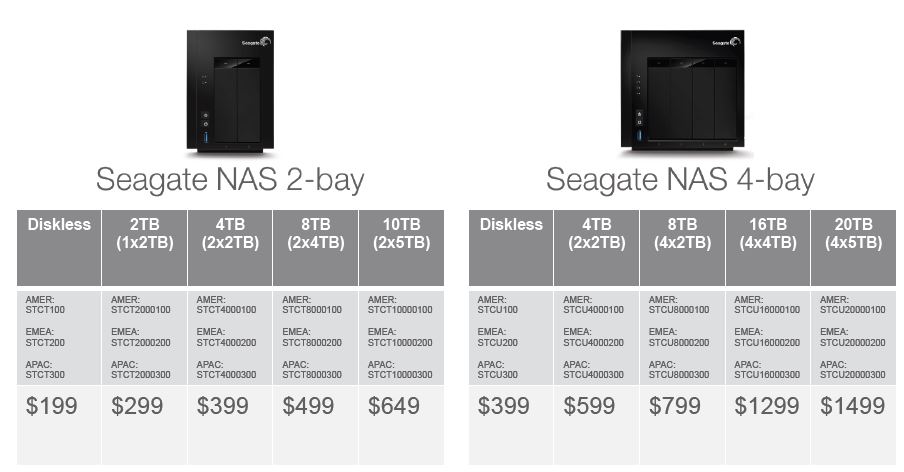
Seagate NAS models
The NAS-2 and -4’s styling couldn’t be simpler. Both are very square matte-black boxes with little adornment. Status is conveyed via multi-colored LEDs and two backlit buttons. I can live without an LCD status panel, but I wish Seagate had included a buzzer.
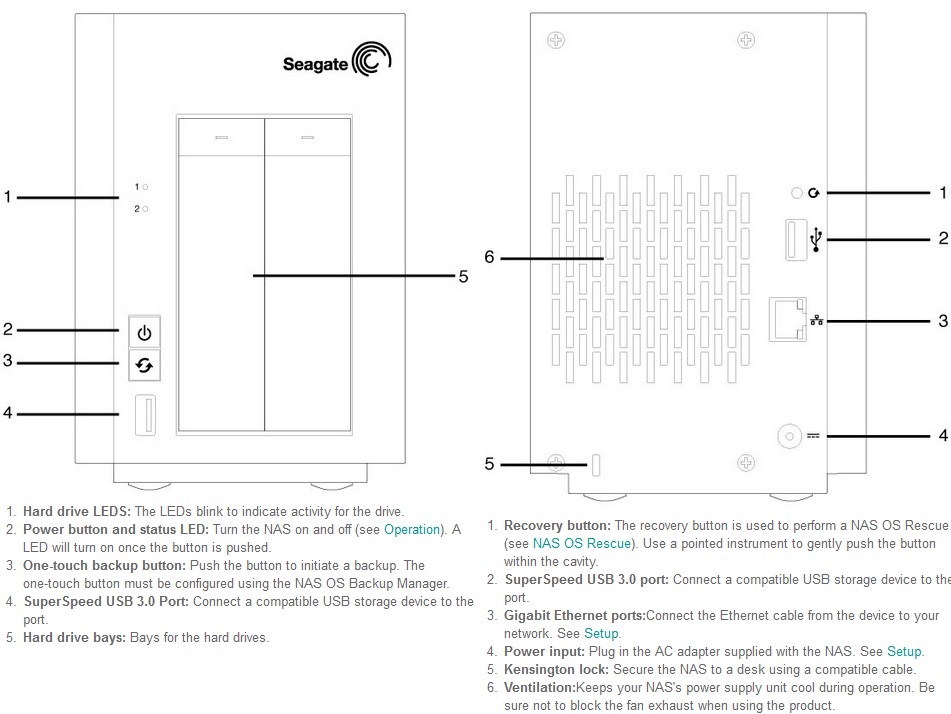
Seagate NAS 2-bay callouts
The callout diagrams above and below show a single Gigabit Ethernet port on the NAS-2 and dual ports on the NAS-4. Both models get two USB 3.0 ports.
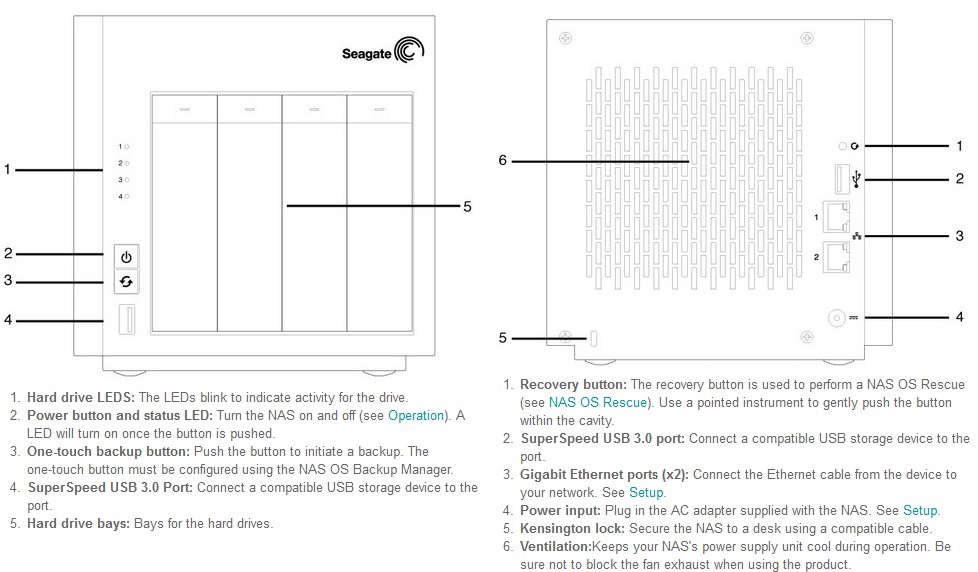
Seagate NAS 4-bay callouts
Memorize the LED chart below. There will be a test later. Maybe a LCD display wouldn’t be such a bad idea…
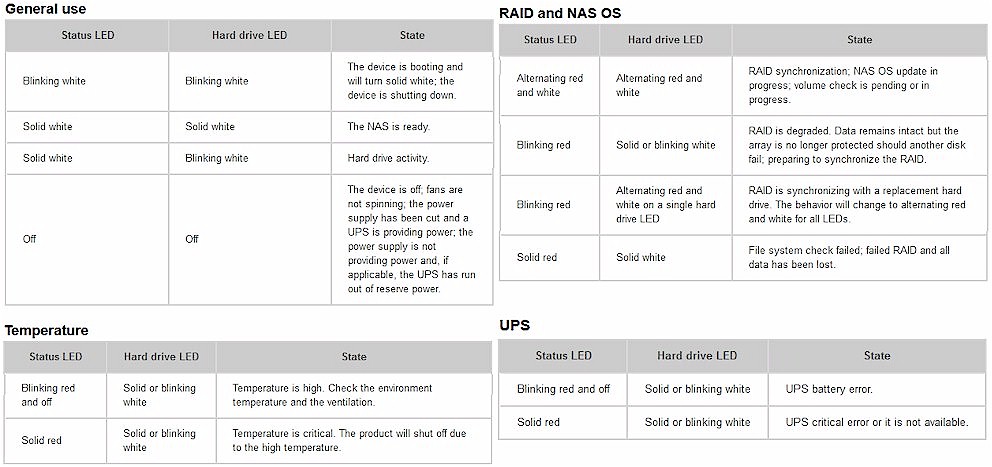
Seagate NAS LED decoder
Seagate sent a 16 TB STCU16000100 NAS-4 configured with four Seagate NAS HDD 4 TB (ST4000VN000) drives. Since the same processor / RAM platform drives both the NAS-2 and -4, I removed two drives and created dual-drive volumes to post NAS-2 test results in the NAS Charts.
Seagate is still in the process of getting documentation posted and linked as I write this and the user manuals are not linked from the NAS or NAS Pro main support pages. So here are the links for the NAS and NAS Pro hardware manuals. The user interface has links for User manual, forums, video tutorials and creating a support case. All work except the User manual link, which currently takes you a page that contains links that send you back to product pages, not manuals.
Updated 8/7/14
The Seagate NAS OS 4 software manual has been posted.
Inside
Both NAS-2 and NAS-4 have a 1.2 GHz Marvell ARMADA 370 at their core. The board photo shows the SoC covered by a heatsink. The board is marked DART – 2BAY – 4BAY so that’s a good clue it is used in both models. The NAS-2 board probably doesn’t have either the Marvell 88E9170 PCIe-to-SATA dual host controller loaded that supports the two additional drives in the NAS-4 or the second Marvell 88E1518 Gigabit Ethernet transceiver.
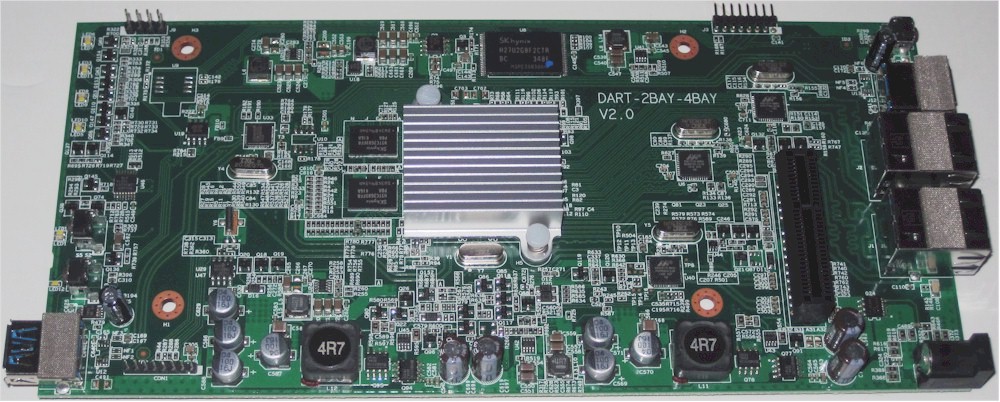
Seagate NAS-4 board
All the key components are summarized in Table 1.
| Seagate NAS-2 | Seagate NAS-4 | |
|---|---|---|
| CPU | Marvell ARMADA 370 @ 1.2 GHz | Marvell ARMADA 370 @ 1.2 GHz |
| RAM | 512 MB DDR3 | 512 MB DDR3 |
| Flash | 128 MB | 128 MB |
| Ethernet | Marvell 88E1518 (x1) | Marvell 88E1518 (x2) |
| SATA | None | Marvell 88E9170 PCIe-to-SATA dual host controller |
| USB 3.0 | Asmedia ASM1042A PCIe dual USB 3.0 | Asmedia ASM1042A |
Table 1: Key component summary
Power draw with drives spun up for the NAS-4 was 29 W and 12 W when they spun down after a programmable idle drive time. I noticed that drives didn’t stay spun down, however, so Seagate needs to work on this. When I loaded only two of the NAS HDDs, total power was 18W with them active and 9 W when they were spun down.
Despite the large 120mm case fan, the NAS-4 got a medium low noise rating since the NAS was clearly audible in my quiet home office. Both fan and drive noise contributed to this.
I should note complete sync for a 4 X 4 TB RAID 5 volume took 25 hours and 10 minutes. This would not affect normal use since the volume is available for use during sync. But it slowed down testing because I have to wait for sync to be completely finished lest the extra drive activity affect test results.
Feature Summary
We first saw Seagate’s NAS OS 4 on the Business Storage 8-Bay Rackmount NAS, which was the first product produced by the merged LaCie / Seagate design team. The feature set appears to have evolved since then and is summarized in the list below. New features are in italics.
Updated 8/7/14: Feature corrections
Storage and Services
- Volume Types: Single drive, JBOD, RAID 0/1/5/6/10
- Volume encryption
- Volume expansion beyond 16 TB
- Hot Spares supported in RAID 5, 6, 10
- Multiple volume support
- SimplyRAID automatic volume management
- User and groups with quotas
- Network file systems supported: SMB/CIFS; AFP; NFS
- Network recycle bin
- FTP / SFTP servers
- WebDAV server
- DFS-N
- Active Directory support
- iSCSI targets
- iSCSI LUN import / export
- iSCSI iSNS support
- UPnP/DLNA server
- iTunes Server
Administration and Remote Access
- HTTP / HTTPS web administration
- SSH root access
- SNMP monitoring
- NAS Configuration export / import
- Easy, no CD setup (discover.seagate.com)
- Email alerts (Seagate SMTP or custom)
- Real-time resource monitoring (CPU, Memory, Network)
- Disk diagnostics and S.M.A.R.T data access
- Sdrive remote access with iOS, Mac OS, Windows and Android apps
- Web File viewer (Web browser) with upload / download
Backup:
- Backup to/from USB drive
- Network backup to rsync, other Seagate NASes, FTP server and SMB, NFS and WebDAV shares
- Internal share-to-share backup
- Cloud backup to Amazon S3 and Box
- Apple Time Machine target
Other features:
- HTTP, FTP, BitTorrent downloaders
- App Manager for installable applications
- Gigabit Ethernet LAN port (dual ports with link aggregation and failover on NAS-4 only)
- Up to 9K jumbo frame support
- IPv6
- Proxy server support for web access
- Networked UPS support
- Dynamic DNS (DynDNS.org, Seagate MyNAS)
Still not supported:
DFS- ISO mounts
- iSCSI initiator
The changes include both minor and major improvements. Among the major are a revamp of remote access features (Sdrive replacing Wuala Hybrid Cloud), installable apps and SSH root access. As a Marvell-powered NAS, the NAS-2 and -4 don’t have the horsepower to host virtual machines, so support for VMware, etc. is not among the specs. I’ll poke around a few of the feature newbies in the next section. The video below nicely highlights key features of NAS OS 4.
Hands On
The look and feel of NAS OS 4 as seen in the NAS-2 and -4 is mostly unchanged from what we saw in the rackmount review. One big change is the addition of the Home screen that you hit upon login. This higher level view and functional grouping makes it easier to get to where you want to go and less likely to get lost.
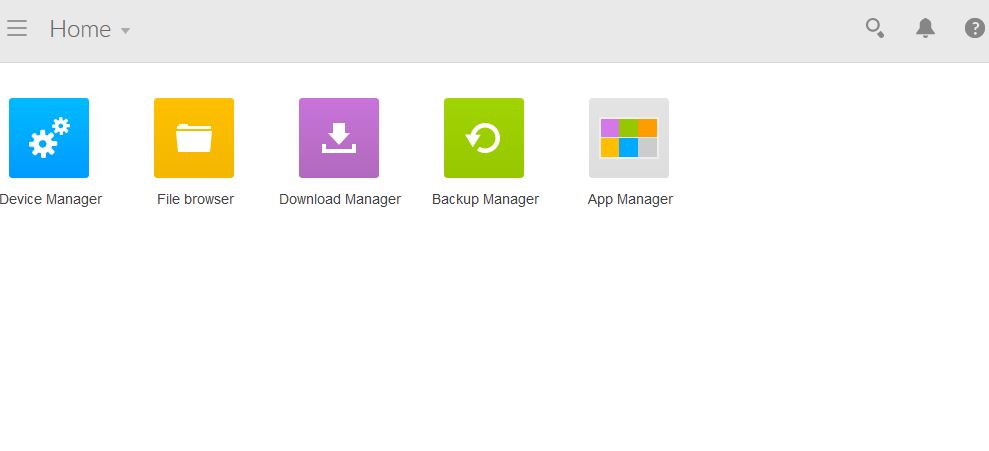
Home screen
NAS OS 4’s visual style remains an homage to LaCie OS and is still too pale for my taste. You can still be fooled into thinking some options are "greyed out", (unavailable) due to the low-contrast color scheme. If this is your first time with the OS, be sure to mouse over things as you explore, as edit options often don’t appear until you do. The GUI is resizable, but only down to a width of 1024 px.
The Device Manager Overview is just that, providing status of key functions. This page isn’t customizable, but you can click on the numbers or words in the lower six modules and go directly to its main admin page. Clicking on the Health Status takes you to the Monitoring main page, complete with Linux process list.
My main complaint here is that the Overview doesn’t reflect volume problems. I took the screenshot below after pulling out Drive #4 of a four-drive RAID 5 volume. The number of disks is properly reflected, but I would say that this condition should not result in Health OK.
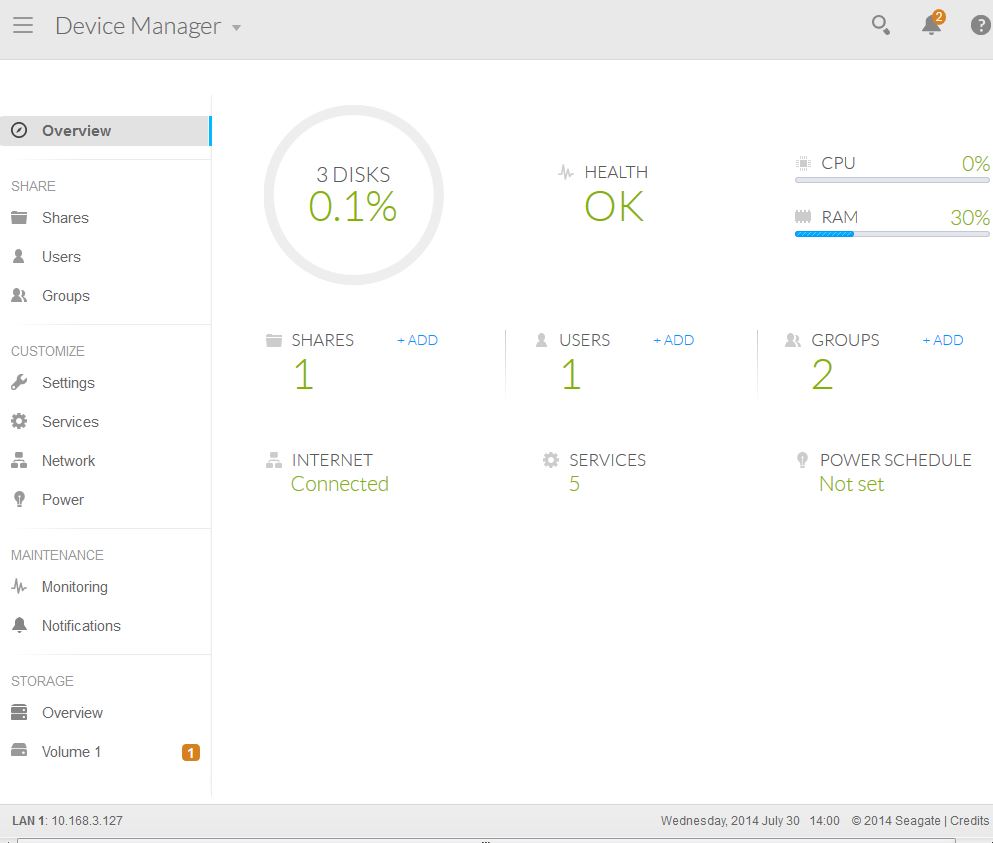
SBS-R8 Welcome page
That little bitty red 1" in the lower left next to Volume 1 is the only GUI clue that something is amiss. But you need to click on it to go to the Volume screen where the problem is clearly spelled out, with a graphic showing a missing drive and everything.
If you happened to be looking at the NAS-4 front panel, you would also notice the power switch backlight turned from white to blinking red. This is where an audible indicator would come in handy.
Many of the admin screens remain the same as those shown in the rackmount’s gallery, so check it out if you’d like to explore more. The gallery below contains views with commentary of new screens found in the NAS-2 and -4.
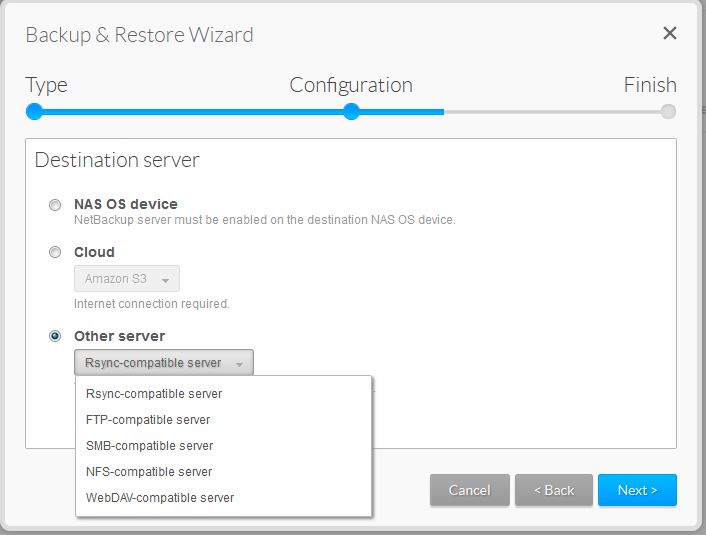
Backup options have expanded to include the network backup options shown plus Cloud backup to Amazon S3 and Box.

Device Manager overview with one drive pulled. iSCSI LUNs are also created here and status monitored.
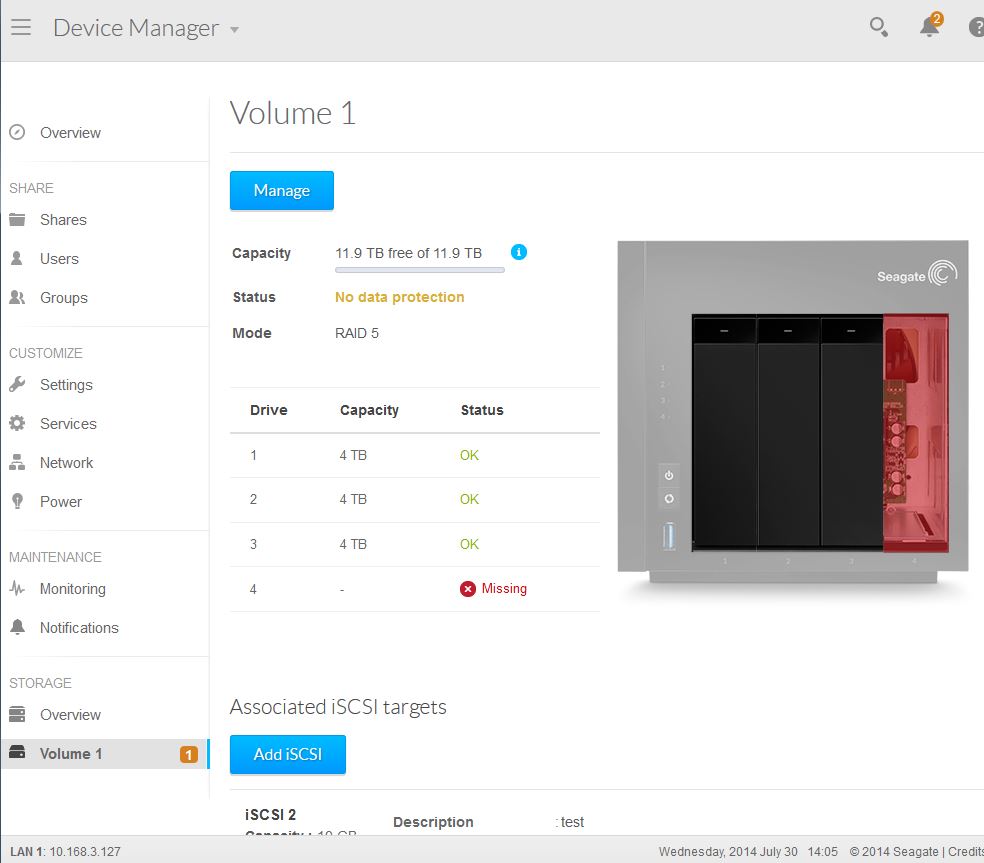
Volume page showing the missing drive.
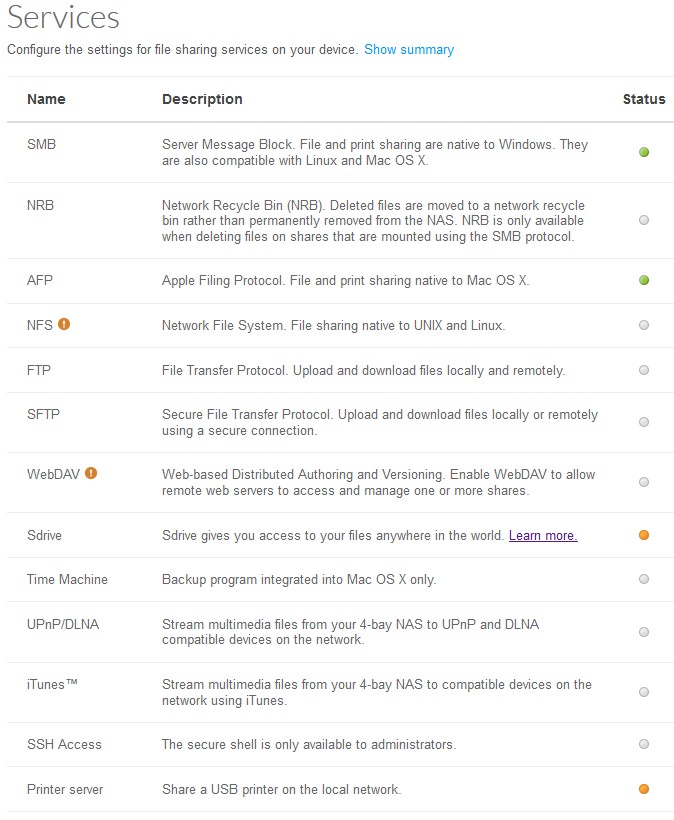
Service list. There are 16 total services.
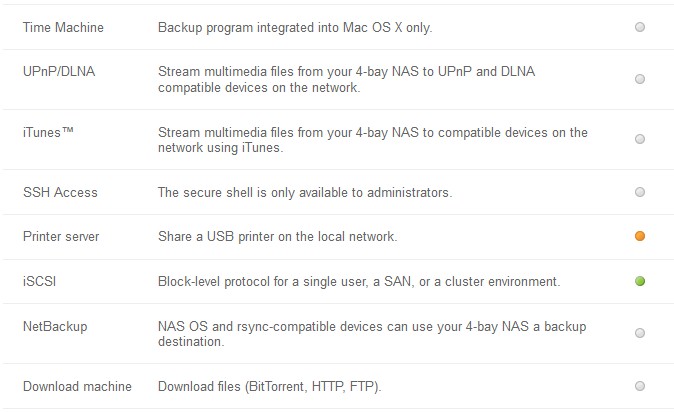
Second half of service list.
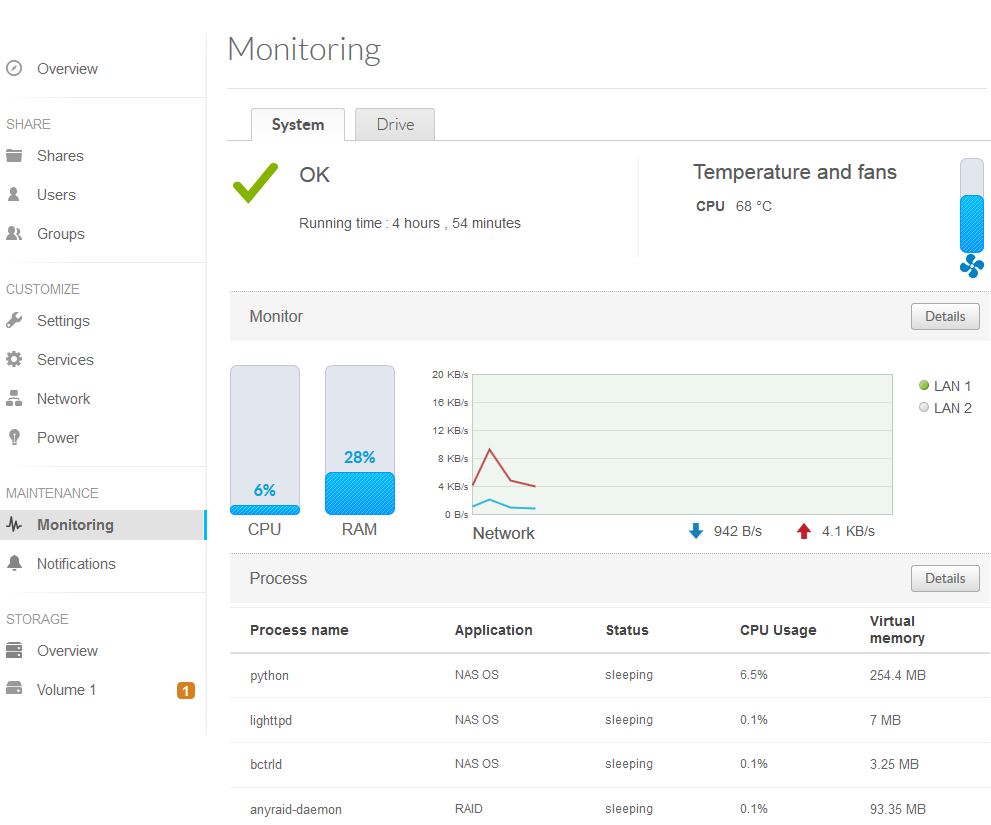
The Monitoring page will make Linux lovers at home with its Process listing
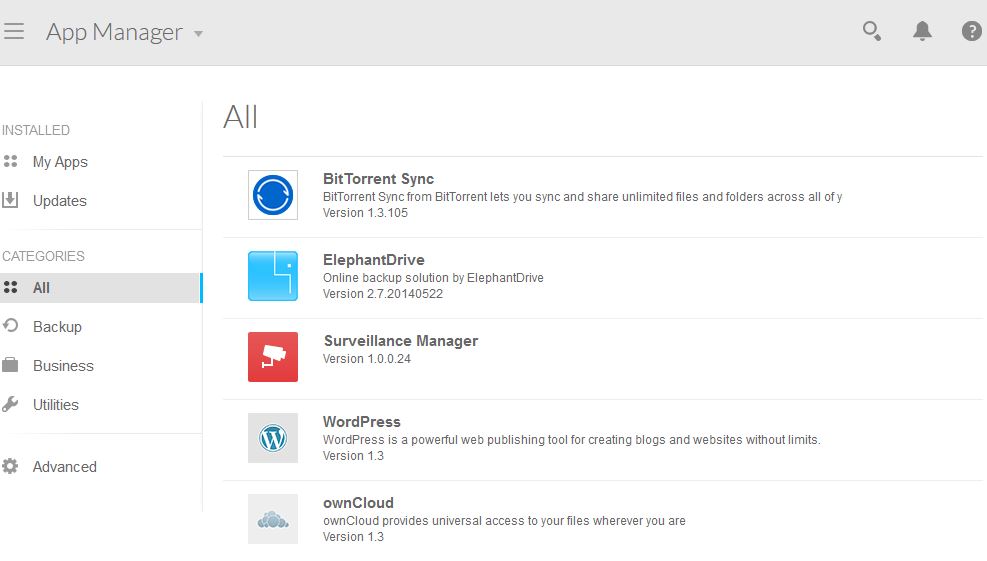
The apps list is rather thin.
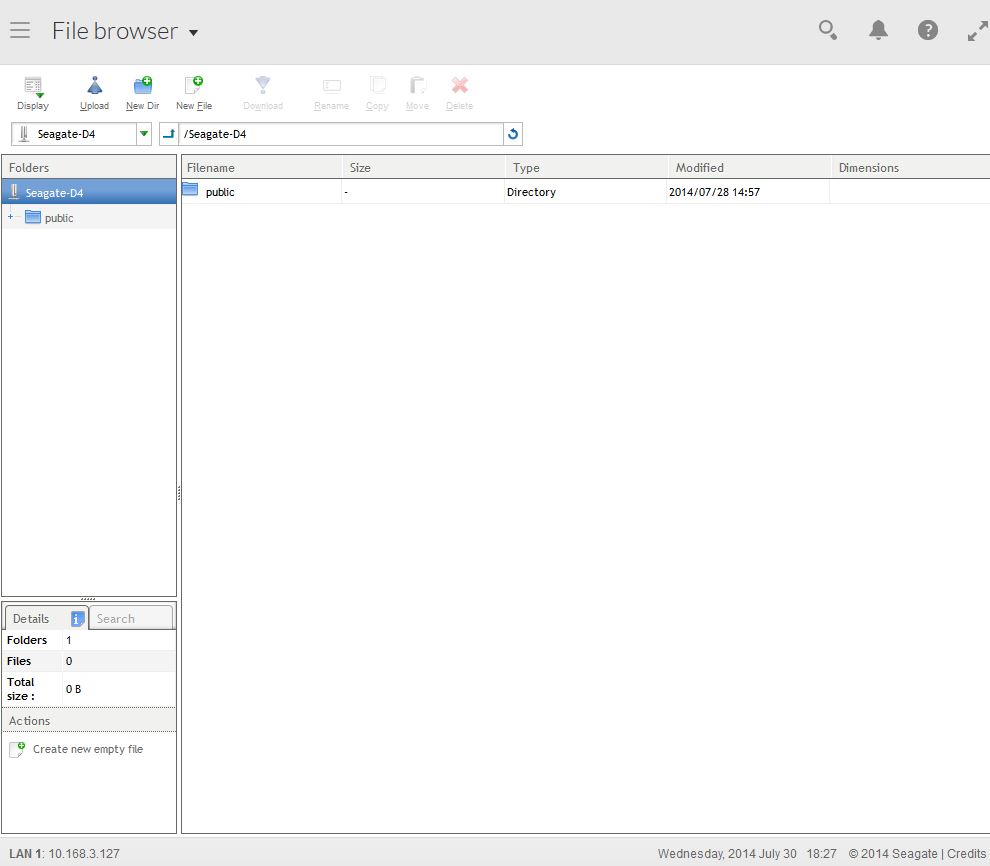
The browser supports upload and download. No online editing, however.
Hands On – more
The number of supported services has been expanded to 16 from the 13 found in the Seagate rackmount review. Additions are Network Recycle Bin, WebDAV and SSH root access. As mentioned earlier, the new Sdrive remote access feature replaces Wuala Hybrid Cloud. The complete list can be found in the gallery.
Seagate still doesn’t bundle any backup clients. But the expansion of backup options to include FTP, SMB shares and NFS mounts provide alternatives not found on many other products (NETGEAR being the most notable exception).
Seagate still has some work to do here, since my attempt to mount a Windows SMB share for backup failed. The NAS couldn’t find the shared folder when I entered either a hostname or IP address. And the search function came up only with my Linksys E4200 router as a target…and it doesn’t even have a disk attached!
Files can also be remotely accessed via the admin interface’s file browser. But this method requires setting up dynamic DNS to reliably remotely access your NAS. Seagate provides two options, DynDNS and its own Seagate MyNAS service. It’s basically a Seagate DDNS that gives your NAS a home on the internet in the form of http://mynas.seagate.com/YOURNAMEHERE.
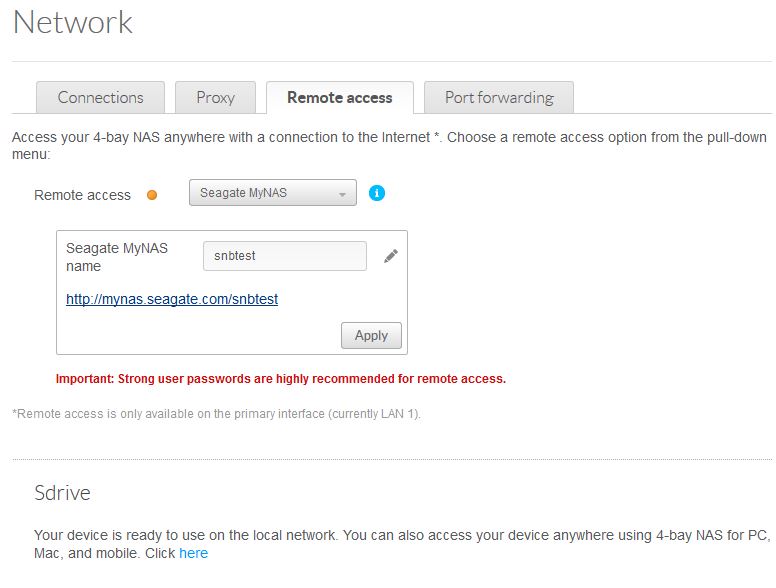
Configuring Remote Access
Since the NAS-2 and -4 support HTTPS access, you can make this a secure connection. The downside is that MyNAS relies on your router supporting UPnP or you manually opening ports in your router firewall. And if you have double-NAT to deal with, this method won’t work at all. I have a double-NAT configuration on my LAN, so Seagate MyNAS was a non-starter for me.
I also tried Sdrive, which replaces Wuala Hybrid Cloud. I was able to download both the Android app and Windows client from the "Click here" link shown in the above screenshot. But the Windows client also installs Java, which I didn’t want to put on the particular system I downloaded it to.
I installed the Android app on a Google Nexus 7 and even created an account. But I could not find a way to register the NAS-4 to the Sdrive account. An email to Seagate wasn’t answered by deadline. When I hear back, I’ll give Sdrive a go again if I still have the products and update the review.
The current version of NAS OS 4 now supports installable apps. But the pickins are kinda slim as you can see below. I didn’t test any of these. The App Manager also provides a manual install mode that lets you install downloaded apps or apps from sources other than Seagate.

Available Apps
Performance
The NAS was tested with 4.0.9.2 firmware using our standard NAS test process. Since the NAS-2 uses the same processor, RAM and Ethernet components, all testing was done using the NAS-4 review sample. The NAS-4 tests used four drives configured in single RAID 0, 5 and 10 volumes. The NAS-2 tests used two drives in single RAID 0 and 1 volumes.
The NAS-4 Benchmark Summary below shows Windows File Copy writes ranging from a low of 39 MB/s in RAID 5 to a high of 51 MB/s with RAID 0 volumes. Lowest File Copy Read was 74 MB/s in RAID 10 and highest was again RAID 0 at 94 MB/s. NASPT results followed the same pattern, but with different results as they usually show. The NAS-4 clearly likes reading better than writing.
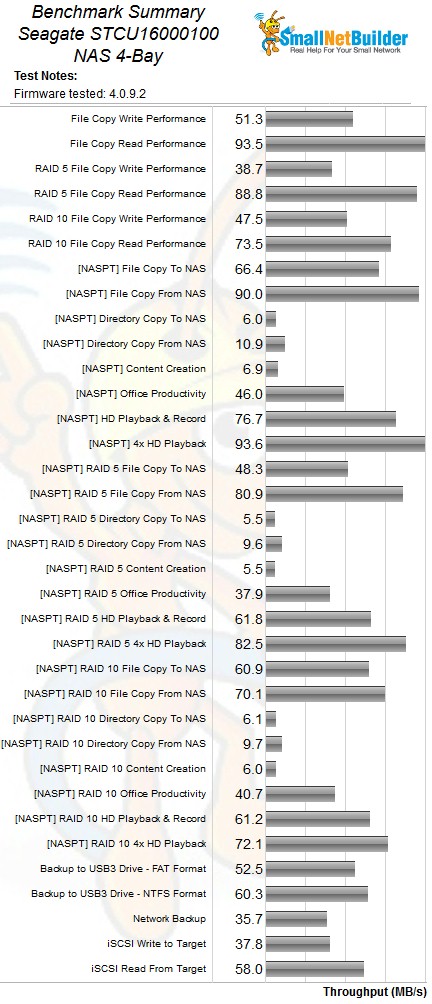
Seagate NAS-4 Benchmark Summary
The NAS-2 results showed the same preference for read with a two-drive RAID 0 volume in the large file Windows Filecopy and NASPT File Copy tests. The only exception was RAID1 NASPT File Copy where write and read were about the same at 60 MB/s.
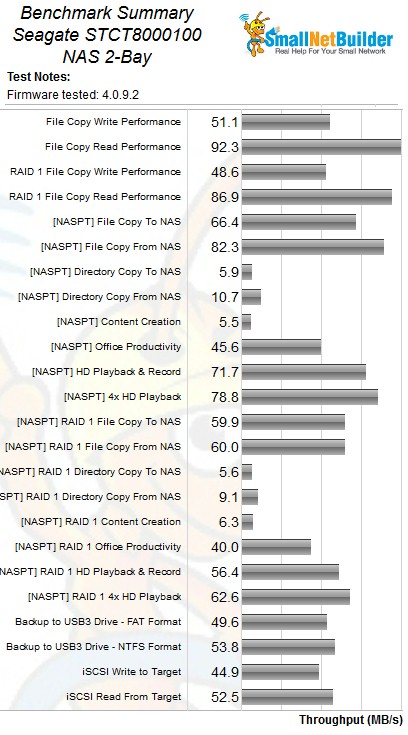
Seagate NAS-2 Benchmark Summary
Attached backup results were very similar between tests with two USB 3.0 connected drives in RAID 1 and four in RAID 5. With no built-in formatter, we got results only for FAT32 and NTFS formatted drives with the former coming in around 50 MB/s for both volume types and the latter close to 60 MB/s from a RAID 5 volume and 54 MB/s for the RAID1. For rsync tests, I could get a connection, but no backup when testing from a RAID1 volume. But when I tried it again with RAID5, it ran and yielded 36 MB/s throughput.
iSCSI reads and writes were different for both RAID1 and 5 volumes. Lowest performance was 38 MB/s for writes to the RAID 5 volume and highest was 58 MB/s reads from the same volume.
Comparative Performance – Four Bay
At the current price of $360 for the diskless STUC100 version, the Seagate NAS-4 is the fourth least expensive four-bay NAS we have reviewed and beats the three less expensive NASes with a performance rank of 45 vs. the next best rank of 54 for QNAP’s TS-420 (lower rank is better).
But for $20 more, you could get a Thecus N4560, which is ranked significantly higher at #34 and powered with an Intel Evansport Atom. My little calculator says buying diskless would be better, too, since buying the Seagate ST4000VN000 4 TB drives from Amazon at $165 a pop totals $1020 (including $360 for the naked NAS) vs. the $1180 Amazon is showing (at time of review) for the 16 TB STCU16000100.
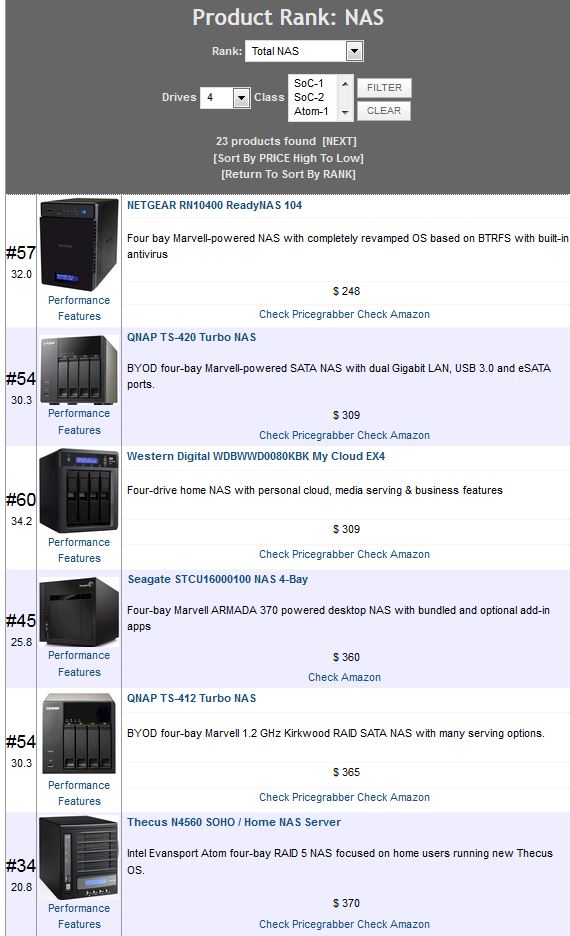
NAS Ranker – 4 bay NASes by ascending price
Comparing the Ranker Performance Summary below shows details of the performance sub-ranks that go into the total rank. Strengths (low numbers) include Video Playback and small folder read/writes (NASPT Office Productivity). Worst sub-rank (highest number) is NASPT RAID 5 File Copy Read even though the 81 MB/s throughput itself isn’t too shabby.
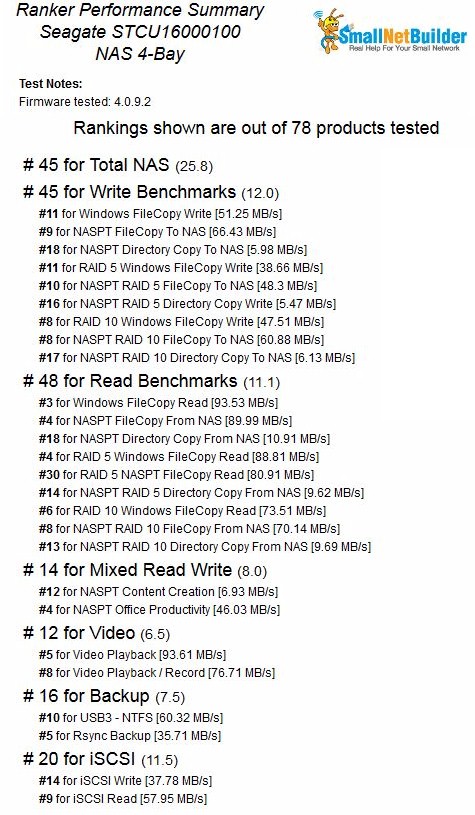
Ranker Performance Summary – four bay
Comparative Performance – Two Bay
Competition for the NAS-2 is tougher because there are a lot more low-cost two-bay products than four-bay. Filtering the NAS Ranker for two drive products and sorting by ascending price finds the diskless model STCT100 NAS-2 as the 11th least expensive at $200.
To make things worse, the NAS-2’s #44 performance rank is bested by five lower cost products including Synology’s DS214se (#29 rank / $153) and Thecus’ N2310 (#30 rank / $143). Looking at the Ranker Performance Summary detail below reveals sub-ranks that aren’t really that bad. But, simply put, the NAS-2 has much more competition in its class and just isn’t as good a deal as the NAS-4 is among its smaller comparison group.
For the NAS-2, buying diskless is again the way to go, although at current prices you save only $60 if my calculations are correct. Since Seagate is still ramping up production, however, I’d expect the diskful model prices for both the NAS-2 and -4 to start heading down soon.

Ranker Performance Summary – two bay
Closing Thoughts
Seagate’s past runs at gaining NAS market share haven’t measured up in performance or features, but have generally been priced attractively. But new product introductions haven’t kept pace with the competition, so Seagate has pretty much been off the radar of most serious NAS buyers.
The NAS-2 and NAS-4 have a shot at changing this. They have competitive feature sets desired by both home and small-biz buyers, are reasonably quiet, power efficient and come in diskless versions desired by savvier buyers. Once high current diskful model pricing gets adjusted to reflect market reality, the NAS-2 and -4 should retain Seagate’s traditional good-value pricing. (Diskless models are already there.) Bottom line, they’re definitely worth your consideration.
